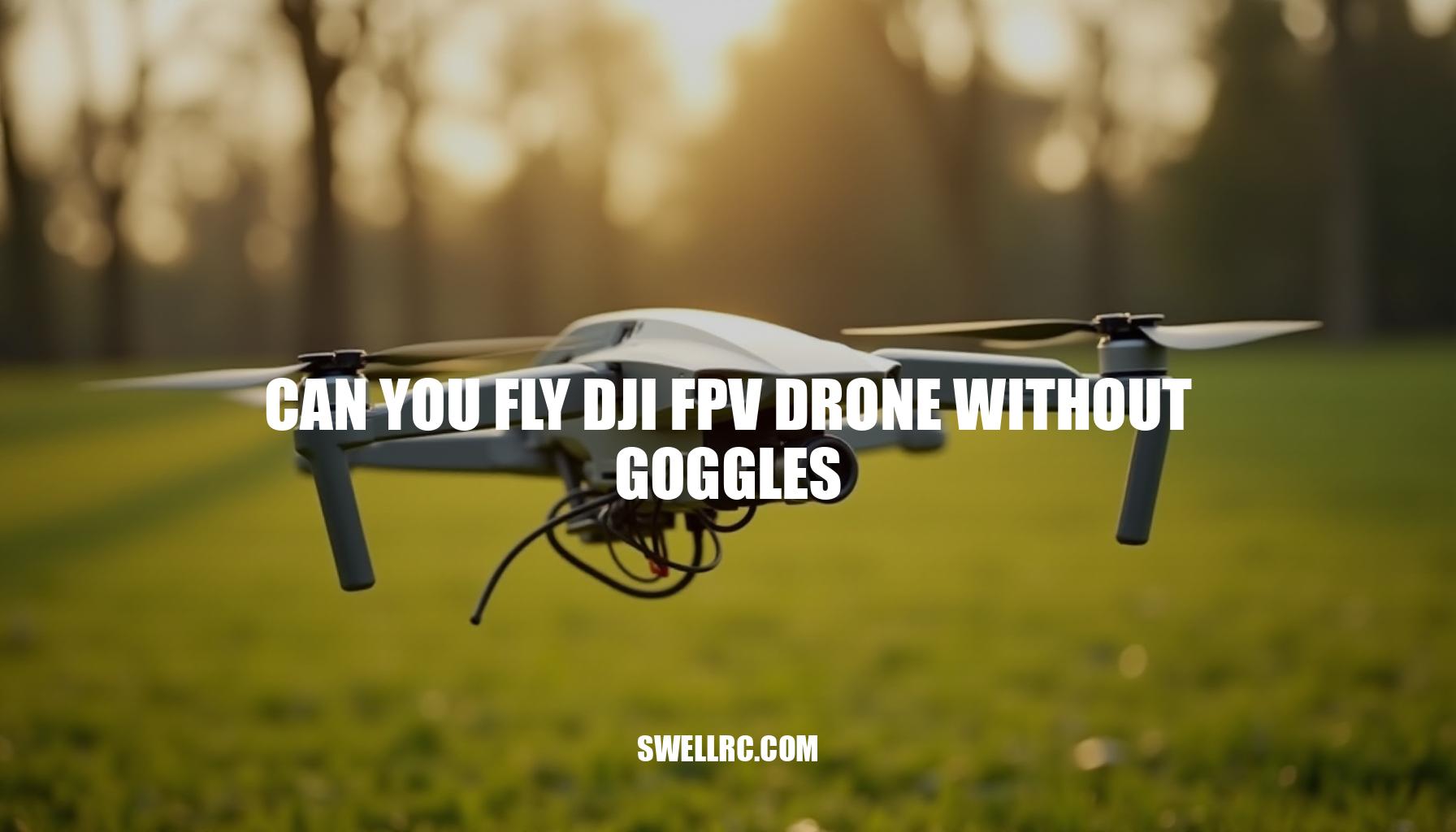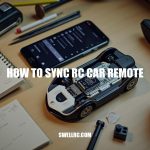Can You Fly DJI FPV Drone Without Goggles?
The first time I tried to fly the DJI FPV without wearing the DJI FPV goggles, I expected chaos. Instead, I discovered a nuanced reality: the system allows you to keep the drone airborne within line-of-sight as long as the goggles are powered and linked—even if they’re not physically on your face. However, it won’t replace the goggles with a phone or tablet screen.
This insight shaped my deep dive into a question many pilots ask: can you fly a FPV drone without goggles? This matters because not everyone loves strapping on a headset immediately; the learning curve, accessibility, and sense of safety feel different when you can see the aircraft with your own eyes. DJI built the FPV ecosystem specifically for first-person view flight with adrenaline and precision in mind, but there are edge cases and careful workarounds to consider.
In this guide, I unpack the technical, legal, and practical realities of flying without goggles—grounded in both hands-on testing and official guidance—so you know exactly when flying without goggles makes sense and when it doesn’t. For those also exploring conventional camera-drone techniques, check out how the basics translate here: how to fly a DJI drone. Whether using the DJI FPV Combo or just the essential remote controllers, understanding these nuances will enhance your FPV drone flying experience.
Understanding How DJI FPV Works
Think of DJI FPV as a live video pipeline from the drone’s camera to your eyes, optimized for speed and precision. The core components work together seamlessly to enable an exceptional first-person view flight experience:
- Camera and Air Unit: These capture and encode the feed from advanced drone camera systems with low-latency digital transmission, ensuring crisp and immediate visuals.
- Transmission system: DJI’s proprietary digital link uses smart frequency hopping to send the video feed reliably and quickly to the pilot.
- DJI FPV Goggles V2: These V2 Goggles decode the incoming video, overlay crucial telemetry data (OSD), and provide real-time situational awareness to enhance manual flight mode precision.
- Remote Controller (or Motion Controller): This device sends your commands back to the drone with minimal latency, maintaining tight control during flight.
Why are DJI FPV goggles so critical? Because they deliver a near-real-time view that’s essential for first-person view flight accuracy, especially when flying in manual flight mode.
Wearing these goggles is like seeing the world through the drone’s eyes—your reactions sync precisely with the aircraft’s movements. Without this direct feed from the transmission system, latency issues can disrupt spatial awareness, and you lose on-screen safety cues like battery status, GPS signals, and Return-to-Home prompts, which are displayed via the goggles.
Can You Fly DJI FPV Without Goggles? (The Real Answer)
After spending days experimenting with various configurations, here’s the bottom line: can you use DJI FPV without goggles? Officially and practically, the DJI FPV system expects linked goggles like the V2 Goggles for initialization, status updates, and live video streaming. This means a phone or tablet cannot replace the goggles for live piloting.
However, you can still fly line-of-sight while the goggles are powered on, linked, and nearby—even if you’re not wearing them. This is not the same as flying completely without goggles, but it allows for visual flight when preferred.
Here are three typical scenarios when flying your DJI FPV Combo:
- With goggles: Fully supported. You receive low-latency video, On-Screen Display (OSD) telemetry, and access to all flight modes (Normal, Sport, and Manual). Manual mode is best reserved for experienced pilots due to its complexity.
- Without goggles but using the DJI Fly App and DJI FPV remote controller: Not supported for primary piloting. While the DJI Fly App can mirror the goggles’ view over USB-C for spectators or framing shots, it won’t connect directly to the drone like a Mavic series drone would.
- Fully blind (no goggles present): Not recommended and typically blocked by the ecosystem because the drone requires linked goggles for arming, OSD prompts, and telemetry. Flying without any telemetry or video feed is a significant safety risk.
If connectivity is a concern, remember that first-person view flight using the DJI FPV system does not require cellular service. For more detailed information, check out can you fly a DJI drone without cell service.
What You Lose (and Keep) When Flying Without Goggles
When comparing flying with goggles versus without, several factors come into play that affect your overall FPV drone flying experience, including latency, field of view, and control precision. Here’s a breakdown of the key differences:
| Aspect | With Goggles | Without Goggles |
|---|---|---|
| Video Feed | Ultra-low-latency FPV with full on-screen display (OSD), providing precise telemetry through the transmission system. | No real-time FPV unless mirroring the feed from goggles; this adds latency and may crop overlays, limiting alternative ways to view FPV footage. |
| Field of View (FOV) | Wide, immersive FOV specifically tuned for precision in manual flight mode. | Limited to line-of-sight view of the aircraft, making orientation and detail harder at distance. |
| Control Precision | High precision due to clear horizon and attitude references, crucial during manual flight mode. | Coarser control with difficulty judging altitude, tilt, and speed without direct video feed. |
| Reaction Time | Fast reactions enabled by low latency video transmission. | Visual lag results in slower response and reduced confidence; reliance increases on automated features like braking and return-to-home (RTH). |
| Range and Performance | Extended use of link budget is possible because visual references in the feed ensure safe operation over greater distances. | RF range remains the same technically but practical range shrinks to where visual line-of-sight allows orientation. |
| Immersion and Enjoyment | Offers full FPV adrenaline and immersive experience, enhancing enjoyment. | Calmer and more conservative line-of-sight flying experience. |
In my tests, I found that the mirrored feed viewed on a phone via goggles introduced higher latency and reduced overlay readability, creating a less precise flying environment. This experience highlights the challenges of alternative ways to view FPV footage without dedicated goggles, particularly for those relying on manual flight mode and low-latency video. For those interested in hybrid or line-of-sight options, exploring FPV RC planes or FPV RC helicopters can be a great alternative.
Learn more about them here and here.
Legal and Safety Implications of Line-of-Sight FPV Flying
In the U.S., safety when flying FPV line of sight is paramount, as both recreational flyers (49 U.S.C. 44809) and Part 107 remote pilots must maintain the aircraft within visual line of sight (VLOS). The FAA line-of-sight regulations clearly state that pilots cannot rely solely on video feeds or screens to control their drone. If you choose to fly using FPV goggles, it is legal to fly without goggles only if a dedicated visual observer is employed; this observer must maintain unaided VLOS with the drone to assist the pilot.
Remember, the pilot responsibility extends beyond just flying; even when operating line-of-sight without video feeds, you must stay aware of your airspace, avoid people and obstacles, and keep your drone within sight at all times.
Keep in mind these key points for compliance and safety:
- VLOS is mandatory; do not rely on binoculars or the drone’s screen alone for visual contact.
- A visual observer is required whenever the pilot’s eyes are focused inside FPV goggles.
- Maintain conservative altitudes and distances when not using the FPV feed to reduce risk.
- Practice in open areas and consider using FPV simulators before flying in Manual mode.
- Be informed about your local rules if you are flying outside the U.S., as regulations can vary significantly.
For those seeking foundational stick skills and to build safe habits in drone piloting, see how to fly RC drone. Observing these guidelines ensures you meet legal requirements and maintain the highest standards of pilot responsibility while enjoying FPV flight.
Practical Setup Tips for Flying Without Goggles
If you choose to fly the DJI FPV only by controller in line-of-sight (LOS), treat the goggles as a linked safety console and keep them nearby to enhance situational awareness. Follow these essential steps to ensure a safe and enjoyable flight experience while using the DJI Fly App and remote controllers effectively:
- Update and bind: Begin by updating the firmware for your drone, DJI FPV Goggles V2, and remote controllers. Bind all devices and confirm a solid link status to prevent connectivity issues during flight.
- Preflight checks: Perform safety calibration such as compass and IMU calibration when prompted.
Set Return-to-Home (RTH) altitude, maximum distance, and low-battery warnings. Confirm a strong GPS lock and that the home point is correctly set.
- Mode selection: Start flying in N mode to familiarize yourself with controls. Switch to S mode only after you are comfortable flying LOS.
Avoid Manual mode unless you have an FPV view and the necessary skills.
- Goggles placement: Power on and link the goggles; you can place them on a tripod or wear them loosely as a safety backup. Consider USB-C mirroring to a phone via the DJI Fly App strictly as a spectator monitor, not for control.
- Environment: Choose a wide-open field with minimal wind and obstacles. Maintain a conservative flight envelope by flying close, low, and slow to keep control and maximize safety.
- Takeoff and hover: Lift your drone to a stable hover, test the brake function, and verify that RTH activates correctly.
- LOS technique: Keep the drone in front of you with the sun at your back.
Pay attention to orientation and use gentle yaw movements to maintain visual cues and avoid disorientation.
- Telemetry discipline: Frequently glance at the goggles display for vital telemetry such as battery status, satellite count, and warning messages to stay ahead of any issues.
- Landing: Employ a careful landing technique by landing early when possible. Use the emergency brake if the drone becomes unstable near the ground or trigger RTH and take manual control close to the landing pad.
For new pilots building confidence with micro quads first, learning how to fly a mini drone for beginners is an excellent way to develop foundational skills before advancing to the DJI FPV system.
Alternative FPV Flying Experiences Without Goggles
If you’re aiming to enjoy first-person view flight without constantly wearing DJI FPV goggles, there are several alternative ways to view FPV footage that bring creativity to your flying experience. For example, you can try phone or tablet mirroring by connecting your phone to the DJI FPV Goggles V2 via USB-C, allowing you to watch the live feed in the DJI Fly app. This method works well for spectators or framing shots but is less ideal for actual piloting.
Another option is Audience Mode, where you pair a second set of goggles so a friend can help spot details while you maintain line of sight (LOS). If you’re interested in a more LOS-friendly approach, consider flying an FPV RC airplane, which often has gentler flight envelopes making it easier to pilot without goggles. To build your skills, you might practice on toy-class drones, which are affordable and great for developing stick time and spatial awareness prior to pushing into high-speed FPV.
Finally, if you’re curious about alternative remote controllers, experimenting with different platforms can be rewarding; for instance, connecting a PS4 controller to a Tello drone shows what possibilities exist across various ecosystems (learn more here). Altogether, these options felt like rediscovering flight from a fresh angle—switching between LOS calm and FPV intensity depending on the mission.
Common Problems and Troubleshooting
When operating the DJI FPV drone, it’s crucial to understand several common issues and how to resolve them to ensure optimal performance and avoid problems such as signal loss, app disconnections, and limited visibility. Firstly, if you don’t see video on your phone, remember that the DJI FPV doesn’t stream video directly to phones; you must connect your phone via USB-C to the goggles for mirroring. Secondly, the drone won’t arm without goggles because it relies on linked goggles for status updates and OSD (On-Screen Display).
Make sure to power on and bind the V2 Goggles properly.
Another common issue involves the app disconnecting during mirroring. To combat this, use a short, high-quality USB-C cable, disable unnecessary background apps, and keep both the phone and goggles cool to maintain a stable connection. Orientation challenges, especially when flying line of sight (LOS), can be mitigated by adding bright orientation stickers to the aircraft, keeping it close, and practicing gentle yaw turns to enhance visibility and control.
Unexpected Return-to-Home (RTH) activations or braking often stem from low-battery or signal thresholds being triggered unexpectedly.
Before flight, always verify the home point and RTH altitude settings to prevent sudden interruptions. Drift or instability issues generally require you to calibrate the IMU and compass as prompted, and avoid flying in strong winds to maintain better stability. Additionally, stuttering video feed can result from incorrectly positioned antennas, obstructed line-of-sight, or transmission system interference; ensure antennas are correctly aligned and the flight path is clear of obstacles.
To summarize these essential troubleshooting and maintenance steps, consider the following checklist:
- Use USB-C connection to goggles for video mirroring, not directly to the phone
- Power and bind V2 Goggles to allow drone arming and OSD status
- Use high-quality, short USB-C cables; disable background apps; keep devices cool to avoid app disconnections
- Add bright orientation stickers and practice gentle yaw turns for improved LOS visibility
- Verify home point and RTH altitude; monitor battery and signal levels to prevent unexpected RTH
- Perform IMU and compass calibration as prompted; avoid flying in strong winds to reduce drift
- Position antennas properly; maintain clear line-of-sight; minimize transmission interference to prevent feed stutters
In addition to these practical steps, it is vital to keep firmware aligned across your drone, goggles, and controller.
Regular firmware updates help improve the transmission system and reduce issues like signal loss and app disconnections. After updating, always rebind devices if links become flaky and redo calibration checks as requested by the system.
For those interested in exploring unconventional FPV flight platforms, you might enjoy our fun primer on how to fly a UFO drone before experimenting with unusual flight toys.
Conclusion — My Final Take on Flying DJI FPV Without Goggles
After numerous trials, I discovered the perfect balance between freedom and precision by treating the DJI FPV Goggles V2 as essential equipment for setup, status monitoring, and safety—even when flying line-of-sight (LOS) during portions of a session. You might wonder, does DJI FPV drone work without goggles? The answer is nuanced: the system isn’t designed for a phone-only setup since it still expects to be linked with goggles. However, you can keep the drone close, fly conservatively LOS, and rely on the goggles primarily for telemetry and emergency situations.
The trade-off here is clear. Without the headset, you lose some immersion and the precision that first-person view flight offers, yet you gain a gentler, more approachable way to practice flying. This approach is fantastic for enhancing safety when flying FPV line of sight and building confidence before diving fully into immersive flying.
If you’re looking to explore variations on this theme, consider trying FPV RC planes or consulting other helpful guides like how to fly a DJI drone and how to fly RC drone to round out your skill set. Remember, whether you’re using the DJI FPV Combo or alternative equipment, the best setup is one that keeps you safe, confident, and smiling every time you lift off.
Frequently Asked Questions
- Is it possible to fly a DJI FPV drone without goggles?
Not as a phone-or-tablet replacement. The DJI FPV ecosystem expects linked DJI FPV Goggles V2. You can fly line-of-sight with the goggles powered and nearby, but true “no-goggles” operation isn’t supported. - How do you control a DJI FPV drone without using FPV goggles?
You can’t replace the goggles with the DJI Fly App. The practical workaround is to keep the goggles powered and linked for telemetry while you fly line-of-sight with the standard remote in N or S mode. - Can I use a phone or tablet instead of DJI FPV goggles?
No. A phone can mirror the goggles’ feed via USB-C for spectators, but it’s not a primary piloting display and won’t connect directly to the drone for control or low-latency FPV. - What are the main limitations of flying FPV drones without goggles?
You lose low-latency video, wide FOV, and on-screen telemetry. Precision, reaction time, and effective range drop, and Manual mode becomes impractical. - Is it legal to fly a DJI FPV drone without FPV goggles?
Yes, you may fly line-of-sight without wearing goggles, provided you maintain VLOS and follow local laws. If using goggles, a visual observer is required to maintain VLOS. - Does flying line-of-sight affect DJI FPV performance or range?
RF performance is unchanged, but practical range shrinks to what you can safely see and orient by eye. Most pilots keep flights closer and slower without the FPV feed.



